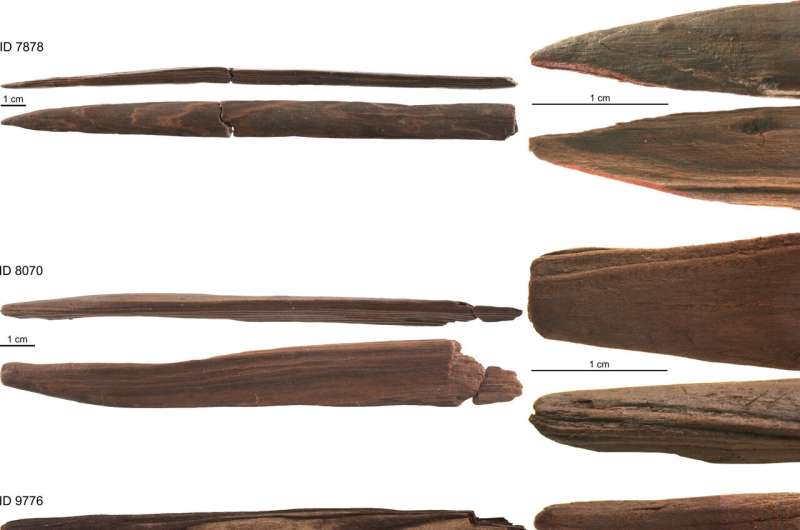This article has been reviewed according to Science X's editorial process and policies. Editors have highlighted the following attributes while ensuring the content's credibility:
fact-checked
peer-reviewed publication
trusted source
proofread
Early humans used wood splitting 300,000 years ago to hunt animals, study shows

Early humans used sophisticated crafting techniques such as "wood splitting" to hunt and to clean animal hides, a new study has revealed.
Using new cutting-edge imaging techniques such as 3D microscopy and micro-CT scanning for the first time, scientists from the Lower Saxony State Office for Cultural Heritage (NLD) and the Universities of Reading and Göttingen examined the oldest complete hunting weapons known to humankind. The weapons, believed to be 300,000 years old, were found during archaeological excavations in Schöningen, Germany in 1994.
The research, published in the Proceedings of the National Academy of Sciences, identifies how pre-Homo sapiens hunters re-sharpened broken points of spears and throwing sticks. Other tools were made by splitting wood, a behavior previously thought only to be practiced by our own species, Homo sapiens. Some tools made from split wood were likely used not for hunting, but to soften and smooth animal skins.
Dr. Dirk Leder, from NLD, said, "There is evidence of much more extensive and varied procedures of spruce and pine woodworking than previously thought. Selected roundwoods were worked into spears and throwing sticks and brought to the site, while broken tools were repaired and recycled on-site."
Dr. Annemieke Milks, from the University of Reading, said, "What surprised us was the high number of point and shaft fragments coming from spears and throwing sticks that were previously unpublished. The way the wooden tools were so expertly manufactured was a revelation to us."
Crucial raw material
At least 20 spears and throwing sticks were among the weapons found at Schöningen three decades ago. In the years that followed, extensive excavations yielded numerous wooden objects dating from the end of a warm interglacial period 300,000 years ago. The findings suggested a hunting ground on the lakeshore.
The wide range of woodworking techniques used on the weapons and tools show the importance of wood as a raw material 300,000 years ago. The Schöningen finds bear witness to extensive experience in woodworking, technical know-how and sophisticated work processes. Project leader Professor Thomas Terberger, who works at the NLD and the University of Göttingen, said, "Wood was a crucial raw material for human evolution, but it is only in Schöningen that it has survived from the Paleolithic period in such great quality."
Schöningen is therefore part of the internationally outstanding cultural heritage of early humankind. Only recently, the site was included in the nomination list for UNESCO World Heritage Site at the request of the state of Lower Saxony.
More information: Dirk Leder et al, The wooden artifacts from Schöningen's Spear Horizon and their place in human evolution, Proceedings of the National Academy of Sciences (2024). DOI: 10.1073/pnas.2320484121
Journal information: Proceedings of the National Academy of Sciences
Provided by University of Reading




















